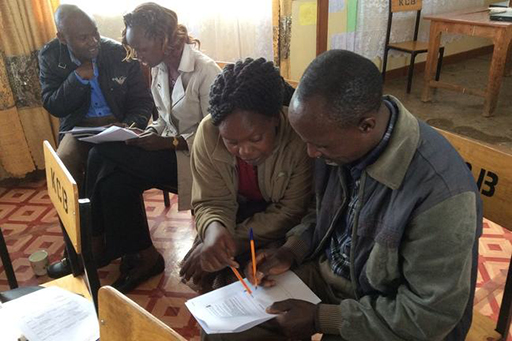Integrating OER

ICT and OER – particularly the TESSA OER – can be used to support the vision for teacher education that you articulated at the start of this course.
Many institutions are currently reviewing their curricula in the light of policy demands for a different approach to teaching. As an individual, you can initiate change by using OER and ICT in your own practice. This is the first step towards more permanent and sustainable change. These changes need to be integrated into programmes by embedding the principles behind active teaching and learning.
You will need to work with colleagues to overcome any perceived barriers to change. In the next activity you will analyse your context and identify opportunities to integrate the TESSA OER and the ideas they contain into teacher education programmes.
Activity 4.5: Integrating OER into teacher education programmes 
Read the case studies below, written by teacher educators about how they have integrated TESSA OER and ICT into their programmes. They are designed to help you think about the different ways in which you might integrate OER into your teaching.
Case Study 1: Developing students’ subject knowledge
Joacim works with Primary school teachers as a Zonal In-Service Co-ordinator in Zambia. In his zone there is concern about some of the teachers’ subject knowledge of Maths. He has been asked to run a session on fractions. He is confident about his own subject knowledge but it is a long time since he has taught it in school. He consulted the Zambian school curriculum and found a reference to a TESSA unit about fractions. He decided to use the ideas in the unit to teach the teachers. They did all the activities in the unit, with him pretending to be the teacher. At the end he checked their understanding of fractions, but realised that by doing it in this way, he had also taught them how to teach fractions. There was an animated discussion at the end about resources that you could use instead of some of those suggested.
Case Study 2: Using ICT to support teaching practice
Charity is a lecturer at a College of Education in Ghana. She had recently bought a SMART phone and was thrilled with all the things it could do and the quality of the pictures she could take. She had been introduced to TESSA materials in a workshop but had not accessed them very much; her friend pointed out that she could get them on her new phone. Her student teachers were out on teaching practice so she downloaded the Teacher Practice Supervisor’s Toolkit. It helped her to think about the sorts of things she should be looking for when observing her student teachers’ teaching. In one lesson, Peter, a science student was doing a demonstration. Many of the pupils could not see the demonstration properly and became quite restless. Charity took some photos of the view that the students at the back of the room had, and in the discussion after the lesson, she showed them to Peter. He was quite shocked and they had a really helpful discussion about how to set up a demonstration and the different strategies he could have used. Next time he did a demonstration, he showed half the class, while the other half worked in pairs on a different task. This time they could all see. Charity started using her phone to support other students; she took small video clips and photos in order to help her students appreciate the learner’s perspective.
Case Study 3: Teaching theoretical content
Tomaida attended a workshop in her college about the TESSA materials. They sounded really interesting and she was able to download them on to her laptop. However, as she browsed the resources she realised that they were mostly based on the school curriculum; that term she was teaching Child Development and Psychology. But she had been struck by what was said in the workshop about making her own teaching more learner-centred. She looked at some of the Key Resources. In the next session she organised her student teachers into groups to work together on various aspects of Child development. In the first task she asked them to think back to their own childhood and identify any milestones they remember about themselves or their siblings. She briefly introduced some theory and then set another task in which they had to think about how these ideas might manifest themselves in the classroom; what sorts of things teachers should be looking for and what sorts of things they could do to support children at different stages in their development.
Case Study 4: Assessing student teachers
On the diploma course in a College of Education student teachers in Kenya were assessed on an exam and on whether they passed their teaching practice. Lecturers decided to introduce an element of course work so that they could assess their student teachers on a greater range of skills. The task involved planning three lessons in a sequence, based on TESSA activities or case studies and then evaluating how the lessons went. They had to submit three lesson plans; a short piece of writing about why they had made their planning decisions; the lesson resources and an evaluation of the lesson which focused on whether the pupils had met the learning outcomes and how they knew. Some lecturers were concerned that because it was not an exam, the students would cheat. However, since they had to write about their own planning and teaching, it was very difficult for them to cheat. If they were concerned that a student could cheat, they could always look in their teaching file and check which topics they had taught. The assignment proved popular with the students and some of the teachers in their schools helped the students by giving feedback on the lessons. The feedback was more helpful than the normal comments about their appearance, punctuality and the quality of their plan.
Now consider the following questions. Write down your thoughts in your study notebook.
- Think about the teacher education that you are involved in. Make a list of the activities that you undertake as a teacher educator. These are likely to include giving lectures, micro-teaching, seminars, tutorials, supervising teaching practice, coaching and mentoring.
- For each activity, list the skills that you want the teacher learners to acquire or develop.
- Choose three of the activities and make notes about:
- Which TESSA OER you might use (Don’t forget the toolkits, audio and Key resources as well as the subject resources.)
- How you might integrate ICT into your practice
- How teacher learners will access the resources
- Whether you will assess teacher learners’ engagement with the TESSA OER and their developing practice. If so, how?
- The challenges you and your colleagues might face in making these changes.
- How you could support each other in overcoming these challenges.
Integrating OER and ICT into existing programmes requires the commitment and co-operation of people at all levels of the organisation.
You may have been working with colleagues, in which case you can compare your answers to the activities and work together to bring about changes. However, many teacher educators will not have heard of OER or TESSA. How can you create an opportunity to share what you have learned?
Activity 4.6: Involving colleagues
Plan a presentation to give to your colleagues. It should be no more than 40 minutes long and should be as interactive as possible. You need to model the approaches that you are trying to promote. Think about how you could use questions, pair work, small group discussion, sorting activities, photographs or video.
Some of the resources you have used in this course might be helpful. You should try and include the following elements:
- The principles behind OER.
- Learner-centred education and what it looks like in practice.
- The TESSA OER.
- Ideas about how to incorporate ICT in teaching to support learning, and some of the challenges.
- How you and your colleagues might use TESSA materials in your teaching, paying attention to how to model active teaching and learning.
- Some consideration of the skills that you collectively need to develop.
Make arrangements to share your presentation with your colleagues.
The OER cycle



